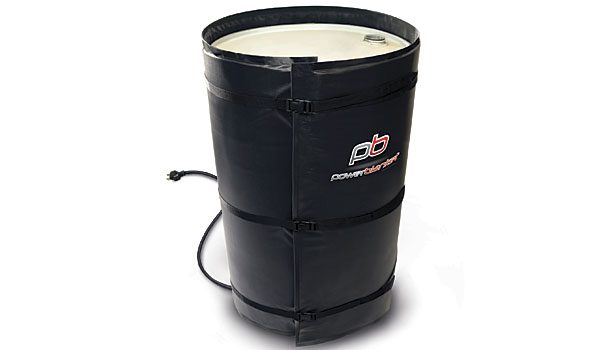Real Freeze Protection




It’s an early morning in January, and you’ve just arrived at the warehouse a bit later than usual. An unexpected cold snap just left the region blanketed in more snow than you’ve seen in a long time. As you step through the frost-laden door, your heart sinks. It’s cold, too cold. You run over to the closest insulated bucket of water-based paint and soon find that your fears are a reality. A small, frozen layer sits on the surface.
It sounds like a nightmare, but it’s a reality that faces any manufacturer, distributor, retailer or application business that has to store epoxy or other coatings in regions that experience freezing temperatures during the winter months. With only traditional methods for freeze protection in place, extreme conditions pose a real threat to the safe storage of the product.
Traditional Freeze-Protection Methods
If you store coatings in cold weather, then perhaps you’ve reverted to two possible methods: cranking up the heat in the warehouse, or using insulated packaging to keep the product from freezing.
The problem is that merely insulating the product from the cold harbors significant limitations, and these limitations could create a potential catastrophe for your business. In addition, dialing up the temperature to heat a massive warehouse eats into operational costs as well.
Insulation Limitations
Storing the product in insulated wraps or boxes requires an additional expense with a fair-weather return on investment (ROI). This is a reality that may seem relatively painless, since a small increase in cost is well worth the protection of the product. However, there’s no guarantee that insulation will actually work. Insulation may keep the product from being affected in moderately cold conditions, but when the needle drops more than usual, there is no guarantee that your investment will pay off.
Another downfall of relying on insulated storage is the simple reality that insulated packaging is no match for extreme cold. If the temperature drops to the teens and below (°F), the product could still be susceptible to freezing.
To expand on the previous point, when it comes to storing epoxies in low temperatures, it’s no longer just about freeze protection. Many epoxies need to be kept within their ideal temperature range in order for the integrity of the product not to be compromised. For many, this temperature range could be as high as 60° to 90°.
If you take the chance and just insulate the product through the cold weather, you could be living the nightmare associated with frozen and damaged product. This not only costs money in damages, but could affect business continuity as well.
Weathering the Warehouse
Heating the warehouse enough to keep paint (especially epoxy) at the proper temperature can eat into the bottom line. If coatings are stored in a heated warehouse, then you really don’t have to worry about insulation for totes, drums or buckets. Instead, you have a heating bill that is much higher than it needs to be. When it comes right down to it, all that needs to be warmed in cold weather is the product itself. However, heating the warehouse is a matter of warming the ambient air surrounding the product to a level that will allow the coatings to maintain proper temperature. In the long run, you’re heating more than you have to.
A Different Solution
A different solution for freeze protection of epoxy and other coatings is now available through an inventive and relatively new technology in the form of heating blankets. Instead of offering mere insulation, the Powerblanket® delivers a barrier of uniform, directional heat where it’s needed most – preventing fluids from freezing and maintaining optimal temperatures. This inventive heat-spreading technology insulates, protects and maintains heat in a wide variety of applications.
Features include:
- Blankets work with both steel and poly containers;
- Full wrap-around design provides complete insulation and ensures equal heat distribution;
- Blankets deliver safe, uniform heat to expensive materials without overheating or burning;
- Patented technology decreases and prevents product waste among temperature-sensitive materials by maintaining consistent storage temperatures without significant fluctuations;
- Energy-efficient, patented technology lowers energy-related expenses and overall project and equipment costs.
With a custom heating solution, you aren’t merely insulating against the cold; you’re actually maintaining an ideal temperature. The thermostat is set to the proper level, and it will remain – keeping the product where it needs to be. Additionally, with a heating solution such as this, you can store a variety of products at different temperatures. Worrying about epoxy’s sensitivity to temperature is no longer a problem.
Tote, Drum and Bucket Heaters
Most heating blanket manufacturers have standard applications for barrels, drums and buckets. Storing coatings in totes and drums is an efficient way to store higher quantities. Drum and tote heaters eliminate waste and lower costs that arise from damaged materials caused by improper storage.
If the product is stored in 5-gallon buckets, then the story is similar. By using an effective heating solution like bucket warmers, materials can last longer and be more effective. In turn, this saves time, hassle and money.
If you have needs beyond the ordinary one-size-fits-all approach, there’s also a solution. Customizable product lines can be developed to cover whatever size or shape needs to be warmed or insulated.
Conclusion
Storing product over the winter months poses inherent risks. Whether it is paint, epoxy, sealant or any other temperature-sensitive liquid, moving outside the ideal range isn’t an option if you’re looking to maintain the products’ longevity. Though traditional means have been the only real answer for a long time, this new technology offers a more cost-effective and low-risk way to keep inventory at the correct temperature.
For more information, visit www.powerblanket.com.
Looking for a reprint of this article?
From high-res PDFs to custom plaques, order your copy today!









